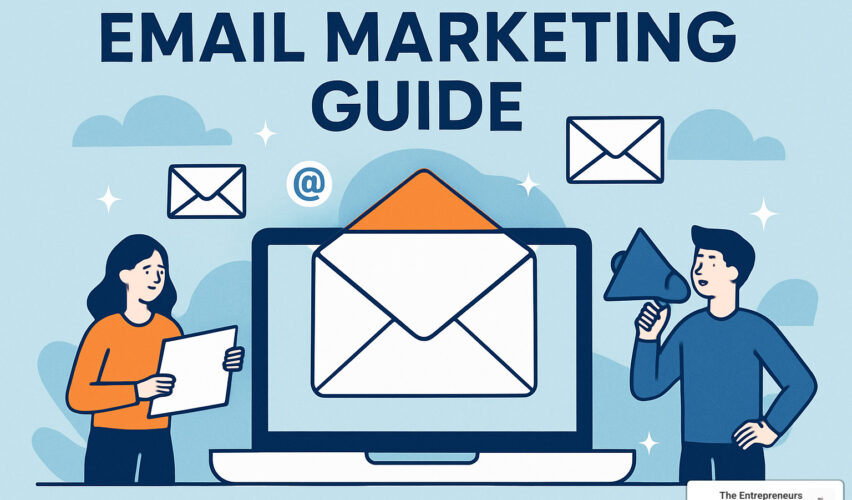The Power of Permission-Based Marketing
Email marketing guide essentials at a glance:
| Component | Key Points |
|---|---|
| Definition | Direct digital communication with prospects/customers via email |
| ROI | $36-$52 for every $1 spent |
| Benefits | High conversion rates, owned audience, measurable results |
| Core Elements | Email list, ESP (Email Service Provider), compelling content |
| Best Practices | Permission-based, segmented, mobile-optimized, tested |
Thanks to email, we can do business with people on the other side of the world in a matter of minutes. The scale is huge, with over 4.3 billion email users worldwide. Yet despite the rise of social media and other marketing channels, email remains the most stable, controllable, and profitable digital marketing channel available to businesses of all sizes.
Would you believe that the first mass email marketing campaign was sent in 1978 by Gary Thuerk, known as the “Father of Spam”? That single campaign to 400 businesses generated over $13 million in sales. Today’s email marketing is far more sophisticated, ethical, and personalized—but the core principle remains: direct communication with people who’ve invited you into their inbox.
Why does email marketing still work so well? Unlike social platforms that can change their algorithms overnight, email gives you direct access to your audience. It’s 40 times more effective at customer acquisition than Facebook and Twitter combined, and segmented campaigns can increase revenue by as much as 760%.
For small businesses and entrepreneurs, email marketing offers an affordable way to compete with larger companies. You own your list—no one can take it away or charge you more to reach the people who’ve opted in to hear from you.
This guide will walk you through everything you need to know about email marketing: from building a quality list and crafting compelling campaigns to choosing the right technology and measuring your success.

Email Marketing 101: Definition, ROI & Benefits
Let’s face it—your inbox probably gets a workout every day. But have you ever wondered why so many businesses are vying for that precious email real estate? As an entrepreneur or small business owner, understanding the power of email marketing could be the game-changer your business needs.
What is Email Marketing?
At its heart, email marketing is simply using email to build relationships with potential customers and keep existing ones engaged. Think of it as having a direct line to your audience—no middlemen, no algorithms deciding who sees your message, just you and your subscribers. It’s one of the few marketing channels where you truly own the relationship.
Unlike posting on social media (where you’re essentially renting space on someone else’s platform), email gives you a direct path to people who have literally raised their hands and said, “Yes, I want to hear from you!” That permission is pure marketing gold.
How Does It Work?
The beauty of email marketing lies in its simplicity. You need three main ingredients to get started:
First, you’ll build an email list—these are the people who’ve given you permission to contact them. Then you’ll need an Email Service Provider (ESP)—the software that helps you design, send, and track your emails (think Mailchimp, ConvertKit, or similar platforms). Finally, you need clear goals for what you want your emails to accomplish.
The typical journey looks something like this: Someone finds your business through your website or social media. They like what they see and sign up for your list. You welcome them with valuable content through your ESP, measure what resonates with them, and gradually segment your audience to deliver more personalized messages. As you learn what works, you can automate certain emails—like welcome sequences or birthday messages—to nurture relationships even while you sleep.
Key Benefits & Stats
The numbers behind email marketing are honestly staggering. For every dollar you spend on email marketing, you can expect an average return of $36-$38—making it the highest ROI digital channel by a long shot. When 73% of consumers say email is their preferred marketing channel, it’s clear we’re not just talking about a nice-to-have marketing tactic.
Email marketing outperforms social media giants by being 40 times more effective at acquiring new customers than Facebook and Twitter combined. This isn’t surprising when you consider that 80% of business professionals view email as essential for customer retention.
What really makes email shine is how personal it can be. When you segment your list and tailor your messages to specific groups, you can boost revenue by as much as 760%. That’s not a typo—personalization pays off in a big way.
Beyond the impressive stats, email marketing gives you benefits you simply can’t get elsewhere:
You have direct access to your audience without paying platforms or fighting algorithms. You own your list completely—no one can take it away or charge you more to reach people who’ve opted in. You can personalize messages based on subscriber behavior and preferences. Once set up, many emails can run on autopilot through automation. Every aspect can be measured precisely, from opens to clicks to sales. And perhaps best of all, email works whether you have 100 subscribers or 100,000.
Mini Email Marketing Guide for Small Businesses
For small businesses with tight budgets, email marketing is particularly powerful. You can reach hundreds or thousands of customers for pennies per email—try getting that ROI from traditional advertising! Regular emails can drive traffic to your website, which in turn can boost your local SEO performance.
Email excels at keeping your business top-of-mind between purchases, which is crucial for building long-term customer relationships. It also levels the playing field, allowing small businesses to deliver the same professional-looking communications as major corporations. Plus, email provides a controlled environment to test different marketing messages before investing in more expensive channels.
If you’re just starting out, keep it simple:
- Choose an affordable ESP with solid customer support
- Create a simple lead magnet that solves a real problem for your audience
- Set up a 3-5 email welcome sequence that introduces new subscribers to your business
- Commit to a regular newsletter (weekly or monthly is fine)
- Pay attention to what works and make small improvements over time
When it comes to email marketing, quality trumps quantity every time. A small list of engaged fans will always outperform a massive list of people who barely remember signing up.
According to research from Statista, the number of email users worldwide continues to grow each year, proving that email isn’t going anywhere—it’s evolving and becoming more important than ever.
Building & Growing Your List the Right Way

Think of your email list as the foundation of your house—if it’s built poorly, everything else will eventually crumble. I’ve seen too many entrepreneurs rush this step, only to wonder why their campaigns aren’t performing months later.
Opt-In & Compliance
Gone are the days when buying email lists was considered a shortcut to success (thank goodness!). Today’s email marketing guide best practices center around permission and trust.
When someone gives you their email address, they’re extending a digital invitation into their personal space. This invitation comes with responsibilities. Laws like GDPR in Europe, CAN-SPAM in the US, and CASL in Canada aren’t just bureaucratic hoops—they protect real people from unwanted messaging.
What does compliance look like in practice? Always include clear consent language when collecting emails. Be transparent about how you’ll use subscriber data in your privacy policy. Make unsubscribing straightforward (no 10-step processes, please!). And always include accurate sender information, including your physical address.
I strongly recommend implementing double opt-in for your list. Yes, it adds an extra step where subscribers must confirm by clicking a link in a verification email. And yes, you might get fewer initial subscribers. But the quality difference is enormous—you’ll build a list of real, engaged humans rather than mistyped addresses or spam traps that can damage your sender reputation.
Lead Magnets That Convert
“Subscribe to my newsletter” rarely cuts it anymore. Today’s savvy internet users want immediate value in exchange for their precious email addresses. Enter the lead magnet—that irresistible freebie that makes signing up a no-brainer.
The best lead magnets solve specific problems quickly. A busy entrepreneur might skip a 100-page ebook but jump at a 2-page checklist that saves them hours of work. A home cook might ignore a generic “cooking tips” offer but eagerly download “5 15-Minute Mediterranean Dinner Templates.”
Some lead magnets that consistently perform well include handy checklists and templates that save time, mini-courses delivered via email, targeted guides on specific challenges, webinars that teach valuable skills, discount codes for immediate savings, free trials of premium offerings, and interactive quizzes with personalized results.
Place these offers strategically where your ideal subscribers will see them—your homepage above the fold, at the end of your most popular blog posts, or as tasteful exit-intent popups. Just remember to clearly communicate what they’ll receive beyond the initial freebie: “Plus weekly actionable tips on growing your side hustle.”
Segmentation Fundamentals
Imagine receiving an email promoting a product you already purchased last week. Or getting content about advanced strategies when you’re still mastering the basics. Frustrating, right? This is why segmentation matters.
Breaking your list into smaller, more targeted groups allows you to send the right message to the right people at the right time. Even basic segmentation can dramatically improve your results.
You can segment based on demographics like location or job title, behaviors such as website activity or purchase history, personal preferences they’ve shared with you, their stage in the customer journey, or even the source of their subscription.
Most email service providers make basic segmentation quite simple. Start with something manageable—perhaps separating new subscribers from established customers, or segmenting based on which lead magnet attracted them. As you grow more comfortable, you can create more sophisticated segments for truly personalized communication.
List Hygiene & Re-engagement
A common misconception is that bigger lists are always better. In reality, a smaller, engaged list will outperform a massive, unresponsive one every time. Regular list maintenance isn’t just good housekeeping—it’s essential for deliverability and effectiveness.
Email providers like Gmail and Outlook track how recipients engage with your messages. If too many subscribers ignore your emails, you’ll eventually land in spam folders across the board. Plus, many ESPs charge based on list size, so keeping inactive subscribers costs you real money.
Develop good hygiene habits: remove hard bounces (invalid emails) immediately, watch for persistent soft bounces (temporary issues that continue), and create a sunset policy for subscribers who haven’t engaged in several months.
Before removing inactive subscribers, try a re-engagement campaign. A simple three-email sequence works well: start with a “We miss you” message including a special offer, follow up with an “Is this goodbye?” email asking if they still want to hear from you, and finish with a “Last chance” note before removal.
Don’t fear pruning your list. As counterintuitive as it seems, removing disengaged subscribers often improves your overall metrics and deliverability. Quality always trumps quantity when it comes to email marketing success.
According to research on collecting email addresses, transparent and value-driven collection methods result in significantly higher engagement rates than aggressive or deceptive tactics. The foundation you build today determines the results you’ll see tomorrow.
Email Marketing Guide: Crafting Campaigns That Convert
With a quality list in place, it’s time to create email campaigns that engage and convert. Let’s explore the anatomy of effective emails and best practices for different types of campaigns.
Email Marketing Guide vs Newsletters
First, let’s clarify an important distinction. Many people use “email marketing” and “newsletters” interchangeably, but they’re not the same:
| Email Marketing | Newsletters |
|---|---|
| Umbrella term for all marketing emails | One specific type of email marketing |
| Includes promotional, transactional, automated emails | Regular updates with curated content |
| Goal-oriented (sales, leads, engagement) | Primarily relationship and brand building |
| Can be one-off or series-based | Typically sent on a consistent schedule |
Your email marketing guide should include various types of emails, not just newsletters. Think of welcome emails that warmly introduce new subscribers to your brand, promotional emails announcing your latest sale, or those helpful order confirmations that reassure customers their purchase went through.
Don’t forget about abandoned cart reminders (we’ve all needed that gentle nudge!), re-engagement emails that thoughtfully win back inactive subscribers, educational content that positions you as an expert, and event invitations that build community around your brand.
Each type serves a different purpose in your overall strategy. For instance, transactional emails primarily confirm an action but can subtly include secondary marketing messages, while promotional emails make no secret of their sales focus.

Subject Lines & Preheaders
Your subject line is the gateway to your email—if it doesn’t compel opening, nothing else matters. The preheader (that snippet of text appearing after the subject line in most email clients) provides additional context and enticement.
When crafting subject lines, brevity wins – 3-5 words often perform best, staying under 50 characters. Try creating a sense of curiosity by posing questions or hinting at valuable content inside. Something as simple as including a recipient’s name can increase open rates by a surprising 26%!
Add a touch of urgency when appropriate (but only when it’s genuine), and always avoid spam triggers like ALL CAPS, excessive punctuation (!!!), or overused words like “free.” Above all, be specific and honest – clickbait might get opens, but disappointment leads to unsubscribes.
For your preheader text, think of it as your subject line’s supportive friend. It should complement your subject line by adding context or continuing the thought. Include a gentle call to action that encourages opening with a clear benefit, and keep it under 100 characters since most devices only show 85-100 characters. Don’t be afraid to test different approaches – questions, statements, or intriguing teasers all have their place.
Here’s a warm example I love:
– Subject: “Quick question for you, Sarah”
Preheader: “I’d love your thoughts on our new product direction…”
This feels personal, creates curiosity, and makes the reader feel valued – who doesn’t want their opinion to matter?
Content & Design Best Practices
The body of your email should deliver on the promise of your subject line while gently guiding recipients toward your desired action.
When writing content, follow the 80/20 rule – 80% valuable content, 20% promotional. Most people skim emails rather than reading every word (we’re all busy!), so short paragraphs of 2-3 sentences maximum work best. Break up text with bullet points and subheadings to give skimmers natural places to pause.
Speak directly to your reader using “you” and “your” liberally – this creates an intimate, one-to-one feeling even when you’re reaching thousands. Match your brand voice consistently across all communications, and whenever possible, tell stories. Human brains are wired for narrative, making stories far more engaging than lists of features.
Always focus on benefits – answer that eternal question “what’s in it for me?” from the reader’s perspective. How will your offer make their life better, easier, or more enjoyable?
For design, think mobile-first since over 60% of emails are opened on smartphones. Use responsive templates that adapt beautifully to different screen sizes. Keep your layout clean and focused – each element should earn its place. Strategic white space gives your content room to breathe and makes the reading experience more pleasant.
Maintain consistent branding with your logo, colors, and fonts, but ensure accessibility with sufficient contrast and readable font sizes (15px or larger). Don’t forget alt text for images since many users have images disabled by default, and consider offering plain text alternatives for subscribers who prefer text-only emails.
The plain text vs. HTML debate continues, but data suggests that simpler emails often perform better. Consider testing plain text or minimal HTML designs against more elaborate templates – you might be surprised which your audience prefers!
Calls to Action That Click
Every marketing email should have a clear purpose and corresponding call to action (CTA). Your CTA is the bridge between engagement and conversion—it needs to be compelling and obvious.
The golden rule? One primary CTA per email. Multiple CTAs compete for attention and can paralyze decision-making. Use clear, action-oriented language like “Start your free trial” instead of the vague “Click here.” For important actions, buttons stand out more than text links, especially when designed with contrasting colors that pop against your background.
Make sure buttons are adequately sized for easy tapping on mobile (at least 44×44 pixels) and strategically placed above the fold, with perhaps a repeat at the end for longer emails. When appropriate, create a sense of urgency (“Shop now – sale ends tonight”) and always set clear expectations about what happens next (“Get instant access” rather than “Submit”).
Don’t be afraid to test different aspects of your CTAs – buttons versus text links, color variations, wording length, and placement within the email. The most effective approach depends entirely on your specific audience and the goal of your email. A thoughtful newsletter might use a subtle “Read more” link, while a limited-time offer needs a bold “Shop now” button to drive immediate action.
The perfect CTA feels like a natural next step, not a pushy sales tactic. When you’ve provided value first, your reader will be looking for that button – make it easy for them to find it!
Technology & Optimization: Platforms, Automation, Testing, Deliverability
Let’s explore the tech side of email marketing – I promise it’s not as intimidating as it sounds! Mastering these elements can transform your results from good to exceptional.
Choosing the Right ESP
Think of your Email Service Provider (ESP) as the engine that powers your email marketing. Finding the right fit is a bit like dating – you need compatibility, room to grow, and a relationship that won’t break the bank.
When shopping for your ESP partner, consider what matters most to your business. Are you planning massive growth? Look for scalability. Working with a tight budget? Pay attention to pricing structures. Not tech-savvy? Prioritize an intuitive interface.
The perfect ESP balances your current needs with future possibilities. Don’t get seduced by flashy features you’ll never use, but don’t settle for a platform you’ll outgrow in six months either. Most importantly, check their deliverability rates – even the prettiest emails are worthless if they never reach the inbox.
Customer support matters more than you might think. When you’re sending an urgent campaign at 9 PM and something breaks, you’ll be grateful for that responsive chat support or phone line.
Automation & Drip Campaigns
Email automation is like having a tireless team member who works 24/7, delivering perfectly timed messages while you focus on other aspects of your business.
Welcome series emails make a fantastic first impression, introducing new subscribers to your brand over 3-5 messages. Abandoned cart recovery gently reminds shoppers about items they’ve left behind, often recovering otherwise lost sales. Post-purchase follow-ups thank customers and ask for feedback, strengthening your relationship.
The beauty of automation is that you set it up once, and it keeps working for you. Your birthday emails will make customers feel special year after year. Your lead nurturing sequence will guide prospects through your sales funnel while you sleep.
When building drip campaigns, think like a storyteller. Each email should naturally flow from the previous one, creating a cohesive journey for your subscriber. Space them appropriately – too many emails too quickly feels overwhelming, while too much time between messages risks losing momentum.

A/B Testing & Send Timing
The most successful email marketers share one habit: they never assume they know what will work best – they test it.
A/B testing is like having a crystal ball that actually works. By sending two versions of your email to different segments of your audience, you can find what truly resonates with your readers.
Start with subject lines – they’re easy to test and dramatically impact open rates. Try a question versus a statement, or test including the recipient’s name. Once you’ve mastered subject line testing, move on to send times, email design, and call-to-action buttons.
Change only one element at a time. If you test both your subject line and your button color simultaneously, you won’t know which change impacted your results.
As for send timing, there’s no universal “best time” to send emails. Your ideal timing depends on your audience’s habits, industry norms, and the nature of your content. B2B audiences often engage more during business hours, while B2C consumers might open more emails on evenings or weekends. Test different days and times, then let your data guide your decisions.
Deliverability & Spam Avoidance
Even the most brilliant email campaign fails if it lands in the spam folder. Deliverability is the unsung hero of email marketing success.
Think of deliverability as your email reputation. Just like in real life, a good reputation takes time to build but can be damaged quickly. Email providers like Gmail and Outlook are constantly evaluating whether your messages deserve the inbox or the spam folder.
Technical factors matter more than you might think. Setting up proper authentication protocols like SPF, DKIM, and DMARC tells email providers “yes, this message is legitimately from us.” Your sender reputation – based on engagement metrics and complaint rates – determines whether providers trust your messages.
The content of your emails matters too. Avoid looking like spam by maintaining a reasonable text-to-image ratio (don’t send an email that’s one giant image with three words of text). Be cautious with “spammy” words like “FREE!” or “GUARANTEE!!!” (especially with excessive punctuation).
Most importantly, respect your subscribers. Send them content they actually want, make unsubscribing easy, and regularly remove unengaged contacts from your list. It feels counterintuitive to remove people from your list, but inactive subscribers hurt your deliverability and cost you money.
Key Metrics & Analytics
You can’t improve what you don’t measure. Understanding your email metrics helps you celebrate wins and identify opportunities for growth.
Open rates (averaging around 18% across industries) tell you how compelling your subject lines are. Low open rates suggest you might need more enticing subject lines or better list quality.
Click-through rates (averaging 2% across industries) reveal how engaging your content is. If people open but don’t click, your content might not be connecting with their needs or your call-to-action might be unclear.
Conversion rates directly tie to your bottom line, showing how many recipients completed your desired action, whether that’s making a purchase, signing up for a webinar, or downloading a resource.
Pay attention to bounce rates too. Hard bounces (permanent delivery failures) should be removed immediately, while soft bounces (temporary issues) should be monitored.
Your unsubscribe rate offers valuable feedback. A spike after a particular campaign might indicate that the content or frequency wasn’t well-received. Generally, keep this below 0.5% per campaign.

Quick FAQs – Email Marketing Guide Essentials
Let’s address some common questions that might be on your mind as you wrap up this email marketing guide:
Q: Does email marketing still work?
A: Absolutely! With ROI ranging from $36-$52 for every dollar spent, email consistently outperforms other digital channels. While social media gets more buzz, email delivers more business.
Q: What’s a good open rate?
A: The industry average hovers around 18%, but this varies widely. B2B companies typically see 15-25%, while e-commerce might range from 12-20%. Rather than obsessing over benchmarks, focus on improving your own trends over time.
Q: How often should I send marketing emails?
A: Most subscribers prefer receiving promotional emails weekly or less frequently. The right cadence depends on your content quality and audience preferences. A great weekly email will outperform mediocre daily messages every time.
Q: Is it better to use HTML or plain text emails?
A: Both have their place. HTML allows for branded design elements, while plain text feels more personal. Many successful marketers use a hybrid approach – HTML with a clean, simple design that doesn’t scream “marketing email.” Test both with your audience.
Q: How do I improve my email deliverability?
A: Focus on quality over quantity. Build a permission-based list, maintain proper technical setup, create valuable content, and regularly remove inactive subscribers. Your deliverability improves when you send engaging content to people who want it.
Q: What’s the best email marketing platform for beginners?
A: Look for user-friendly interfaces, responsive templates, basic automation, and helpful support. Start with the features you’ll actually use today rather than paying for advanced capabilities you might need someday.
Q: How do I grow my email list quickly?
A: Focus on quality growth through valuable lead magnets, optimized website signup forms, and content upgrades on your most popular blog posts. Avoid the temptation to purchase lists – they damage your deliverability and violate regulations.
Looking to improve your digital marketing skills beyond email? Check out our Basic Digital Marketing Course for a comprehensive introduction to all digital channels.
Conclusion
Email marketing remains one of the most powerful tools in an entrepreneur’s arsenal. When you think about it, there aren’t many marketing channels that give you direct access to your audience while delivering a $36+ return for every dollar spent. That’s the kind of efficiency that can transform a small business.
Throughout this email marketing guide, we’ve covered a lot of ground together. If you’re feeling a bit overwhelmed, don’t worry—that’s completely normal. The beauty of email marketing is that you can start simple and grow your sophistication over time.
Let’s revisit the essentials we’ve explored:
Building a quality list is your foundation. 500 engaged subscribers who love hearing from you will generate better results than 5,000 people who barely remember signing up. Your lead magnets are the gateway to growing this valuable asset—make them irresistibly helpful.
Segmentation is where the magic happens. When you send different messages to different groups based on their interests or behaviors, you’re essentially saying, “I see you as an individual.” That personal touch makes all the difference in a crowded inbox.
The emails themselves need to deliver on the promise of your subject line. Clear, concise writing with a compelling call to action will guide your readers toward the next step in their journey with you. Don’t overthink it—sometimes the simplest emails perform the best.
Automation allows you to be in multiple places at once, nurturing relationships while you focus on other aspects of your business. A basic welcome sequence can work wonders while you sleep.
Testing isn’t just for the marketing nerds—it’s how you find what resonates with your unique audience. Small improvements add up to significant results over time.
Deliverability might seem technical, but it’s really about respect. When you honor best practices, you’re respecting both your subscribers and the email ecosystem that connects you.
Above all, consistent value keeps the relationship strong. Every email is an opportunity to help, delight, or solve a problem for your subscribers.
At TheEntrepreneurs.net, we believe in starting small and scaling with success. Begin with just the fundamentals—a simple lead magnet, welcome sequence, and regular newsletter—then expand as you gain confidence and see results.
Email marketing blends technical know-how with human connection. Behind every email address is a person with needs, challenges, and goals. When you genuinely aim to help them—not just sell to them—your email marketing transforms from mere messages to meaningful conversations.
Ready to take your email marketing to the next level? Explore our marketing resources for more insights and strategies to grow your business through effective digital communication. You might also want to check out our Basic Digital Marketing Course to build a solid foundation across all digital channels.
What aspect of email marketing will you implement or improve first? Start small, measure results, and keep refining your approach. Your future customers are waiting in their inboxes—and with what you’ve learned in this guide, you’re ready to meet them there.





















